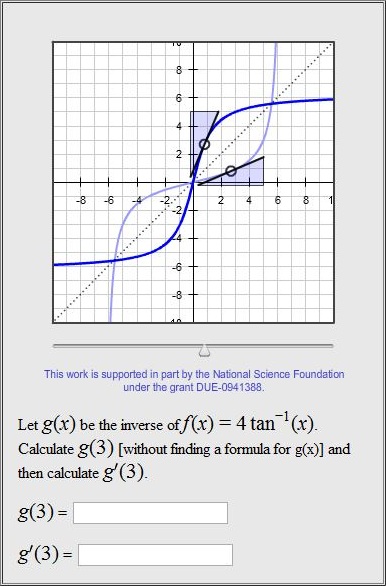InverseGraph
Flash Applets embedded in WeBWorK questions GraphLimit Example
Sample Problem with InverseGraph.swf embedded
This sample problem shows how to use this versatile applet.
This applet and WeBWorK problem are based upon work supported by the National Science Foundation under Grant Number DUE-0941388.
A standard WeBWorK PG file with an embedded applet has six sections:
- A tagging and description section, that describes the problem for future users and authors,
- An initialization section, that loads required macros for the problem,
- A problem set-up section that sets variables specific to the problem,
- An Applet link section that inserts the applet and configures it, (this section is not present in WeBWorK problems without an embedded applet)
- A text section, that gives the text that is shown to the student, and
- An answer and solution section, that specifies how the answer(s) to the problem is(are) marked for correctness, and gives a solution that may be shown to the student after the problem set is complete.
The sample file attached to this page shows this; below the file is shown to the left, with a second column on its right that explains the different parts of the problem that are indicated above. A screenshot of the applet embedded in this WeBWorK problem is shown below:

Other useful links:
Flash Applets Tutorial
Things to consider in developing WeBWorK problems with embedded Flash applets
| PG problem file | Explanation |
|---|---|
##DESCRIPTION
## Inverse Graph
## Sample problem to illustrate
## the use of the InverseGraph.swf
## Flash applet
##ENDDESCRIPTION
## KEYWORDS('calculus','derivatives',
## 'inverse functions')
## DBsubject('Calculus')
## DBchapter('Differentiation')
## DBsection('Derivatives of Inverse Functions')
## Date('8/16/2011')
## Author('Alex Yates')
## Institution('Cleveland State University')
## TitleText1('Calculus: Early Transcendentals 2e')
## EditionText1(2)
## AuthorText1('Rogawski')
## Section1('3.8')
## Problem1('9')
###########################################
# This work is supported in part by
# the National Science Foundation
# under the grant DUE-0941388.
###########################################
|
This is the tagging and description section of the problem. Note that any line that begins with a "#" character is a comment for other authors who read the problem, and is not interpreted by WeBWorK. The description is provided to give a quick summary of the problem so that someone reading it later knows what it does without having to read through all of the problem code. All of the tagging information exists to allow the problem to be easily indexed. Because this is a sample problem there isn't a textbook per se, and we've used some default tagging values. There is an on-line list of current chapter and section names and a similar list of keywords. The list of keywords should be comma separated and quoted (e.g., KEYWORDS('calculus','derivatives')). |
DOCUMENT(); loadMacros( "PGstandard.pl", "AppletObjects.pl", "MathObjects.pl" ); |
This is the initialization section of the problem. The first executed line of the problem must be the
The |
###################################
# Setup
###################################
@funcArray = (
"1/4*x^3-1",
"x+cos(x)",
"1/4*x^3-2*x",
"4*atan(x)",
"x*atan(x)",
"1/2*x^(2)",
"x-(x/2)^3"
);
@dispArray = (
"\frac{1}{4} x^3 - 1",
"x+\cos(x)",
"\frac{1}{4} x^3 - 2 x",
"4 \tan^{-1}(x)",
"x \tan^{-1}(x)",
"\frac{1}{2}x^2",
"x-(\frac{1}{2}x)^3"
);
$rand = random(0,6,1);
$func = @funcArray[$rand];
$f = Formula($func);
$yval = random(1,3,1);
$ans1 = $f->substitute(x=>$yval);
$fder = $f->D();
$ans2 = 1/($fder->substitute(x=>$yval));
|
The GraphLimits.swf applet will accept four different question types, specified with the
The applet has solution/hint information embedded in it. When
The four variables
|
###################################
# Create link to applet
###################################
$appletName = "InverseGraph";
$applet = FlashApplet(
codebase
=> findAppletCodebase("$appletName.swf"),
appletName => $appletName,
setStateAlias => 'setXML',
getStateAlias => 'getXML',
setConfigAlias => 'setConfig',
height => '400',
width => '350',
bgcolor => '#e8e8e8',
debugMode => 0,
submitActionScript => '',
);
|
This is the Applet link section of the problem. If you are embedding
a different applet, from the InverseGraph
applet, put your applet name in place of
'InverseGraph' in the line |
###################################
# Configure applet
###################################
$applet->configuration(qq{
<XML><Vars func = '$func'/></XML>});
$applet->initialState(qq{
<XML><Vars func = '$func'/></XML>});
|
The lines and |
Context()->texStrings;
TEXT(beginproblem());
BEGIN_TEXT
$PAR
\{ $applet->insertAll(debug=>0,
includeAnswerBox=>0,
reinitialize_button=>0,) \}
$PAR
Let \(g(x)\) be the inverse of
\(f(x)=$dispArray[$rand]\). Calculate
\(g($yval)\) [without finding a formula
for g(x)] and then calculate \(g'($yval)\).
$PAR \(g($yval)\) = \{ans_rule()\}
$PAR \(g'($yval)\) = \{ans_rule()\}
END_TEXT
|
This is the text section
of the problem. The
Mathematical equations are delimited by
There are a number of variables that set
formatting: |
################################### # Answers ################################### ANS(num_cmp($ans1)); ANS(num_cmp($ans2)); ENDDOCUMENT(); |
This is the answer
section of the problem. The problem answer
is set by the
The |
License
The Flash applets developed under DUE-0941388 are protected under the following license: Creative Commons Attribution-NonCommercial 3.0 Unported License.